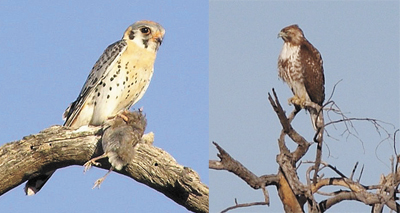Taking hawks not state-sanctioned – poaching update
By Linda Bentley | January 14, 2009
If what they were doing was legal, they wouldn’t have been lying
DESERT FOOTHILLS – Following last week’s article, “Taking Harris Hawks not a crime in Arizona,” a call from Spur Cross Conservation Area Supervisor John Gunn and Wild at Heart’s Bob Fox filled in a rather large gap and answered the question as to why the threesome that had taken a Harris Hawk lied about who they were and what they were doing, if what they were doing was legal.

According to Gunn, there is a large black market for Harris Hawks, which are popular for the sport of falconry because they are social birds and hunt in groups.
Young Harris Hawks are known to stay with their family unit for two to three years to help raise subsequent broods and hunt cooperatively with the family.
While the section of statute dealing with “times when wildlife may be taken” does not point to any other section of statute or regulatory authority, Gunn said there are strict licensing requirements and numerous restrictions regarding the legal taking of raptors, which are addressed in a separate section.
There are different regulations, bag limits and possession limits for Class I (apprentice), Class II (general) and Class III (master) falconry licenses.
To understand some of the regulations, one needs to understand the language of falconry.
For example: A young hawk taken from a nest in the wild or bred in captivity is called an “eyas,” while a hawk snared during its first year in the wild is considered a “passage” raptor.
Obtaining a Class I permit requires having a sponsor, training, and passing a test.
Provided all state, federal and hunting licenses are in order, Class I falconers may capture one replacement raptor and Class II and Class III falconers may capture two raptors alive per 12-month period.
Class I falconers are limited to the capture of one passage American Kestrel or Red-tailed Hawk between Jan. 1 to Jan. 31 and Sept. 15 to Dec. 31.
Class I falconers may possess one raptor; Class II falconers may possess two raptors; and Class III falconers may possess three raptors.
One must be a Class II or Class III falconer to capture a Harris Hawk, which, along with Northern Goshawks and Peregrine falcons, must be banded by the Arizona Department of Game and Fish within five days of capture.
Regulations indicate certain raptors may be taken from “open areas” and “statewide.” However, it states “open areas” do not include any area closed to hunting, fishing or trapping and “statewide” excludes wildlife areas not open for hunting.
The county island area near 66th Street and Montgomery Road, where the three poachers were spotted snaring a Harris Hawk a couple of weeks ago, is a residential area, private property and not designated an open area for hunting.
According to Sam Fox from Wild at Heart, the reason the three stopped to offer information to Susan Barbetti, rather than just drive off, knowing she witnessed the theft of a Harris Hawk, was most likely to attempt to legitimatize their actions to Barbetti long enough to prevent their license plate from being recorded and reported.
Possession, importation, transportation, selling or trading of live wildlife, except as authorized by the game and fish commission is also a crime.
Basically, the taking of any wildlife in the area, with the exception of sparrows, starlings and pigeons, is indeed poaching and if anyone does witness any such activity, they should attempt to get the vehicle make and license number and call Arizona Game and Fish
Department’s 24-hour Operation Game Thief number: 800-352-0700 or 911 if it is a crime in progress.
Statute also requires all peace officers in the state and other authorized state and federal employees enforce these provisions.
Photo by Linda Bentley
Only state and federally licensed falconers with valid hunting licenses are permitted to take raptors for the purpose of sport falconry from areas open for hunting during designated hunting seasons. A Class I (apprentice) falconer is limited to capture of passage American Kestrels (l) and Red-tailed Hawks (r).
